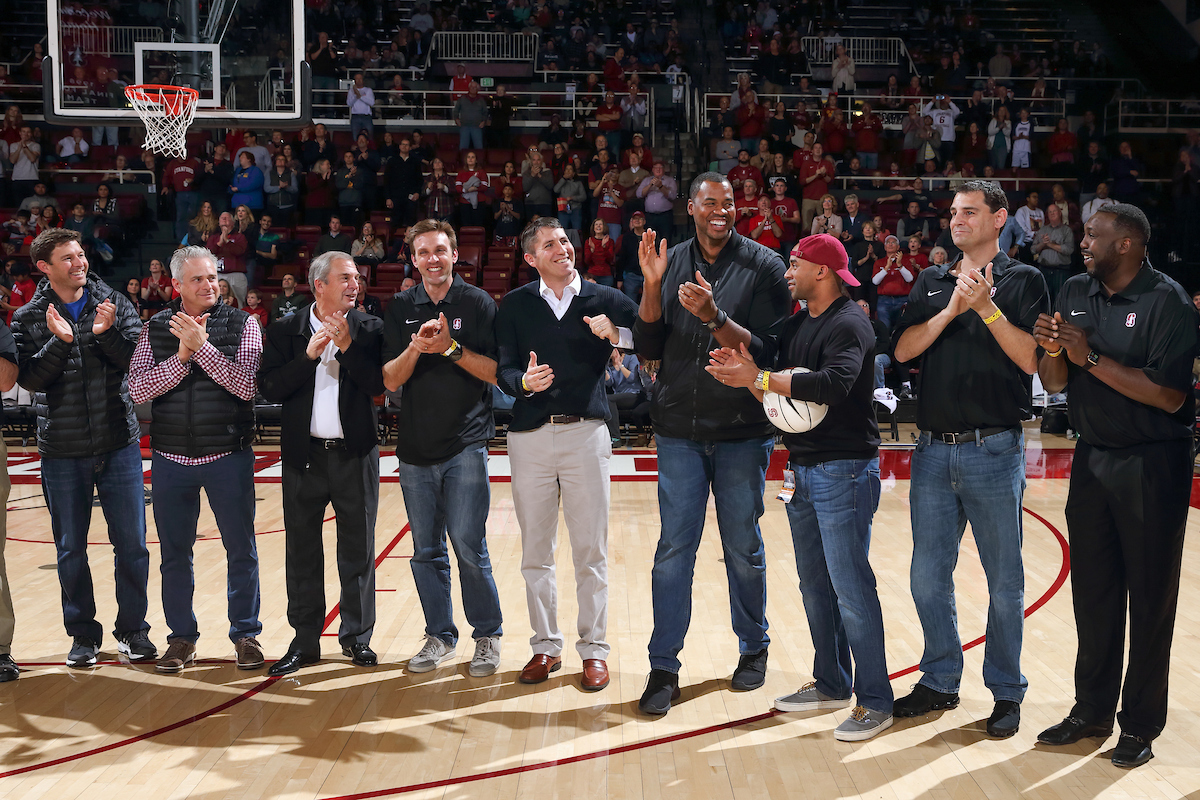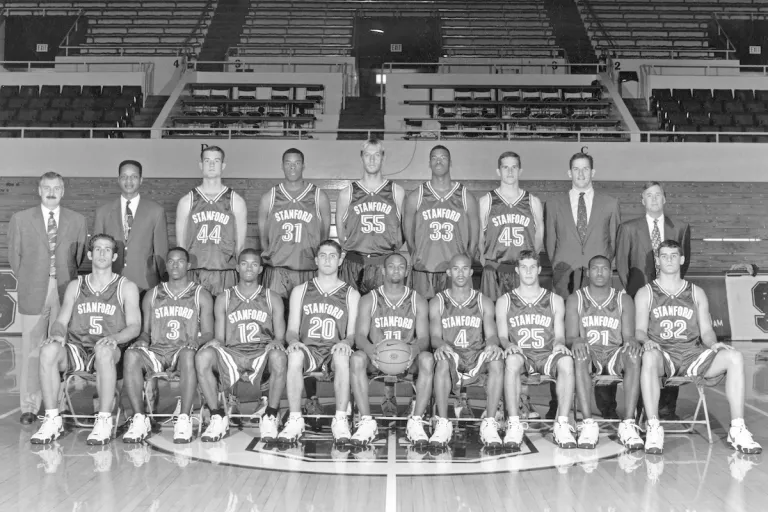“In the three years that I coached at Stanford, every game was sold out,” said Blaine Taylor, an assistant coach for Stanford men’s basketball team from 1998 to 2001.
No, this wasn’t Cameron Indoor Stadium, the Dean Dome, or Rupp Arena. This was Maples Pavilion at its peak in the late 1990s and early 2000s.
But who was the architect that drew large crowds to Maples every week and why were these crowds there? Looking at Stanford basketball’s history over the last 50 years, we have to trace the origins of this success to the turn of the century.
Origins of success
For about a 50-year stretch, Stanford men’s basketball was mired in mediocrity. After winning an NCAA championship in 1942, the program suffered a 47-year drought of NCAA tournament appearances. The coaching tenures of Howie Dallmar, Dick DiBlasio and Tom Davis did little to inspire a restless fanbase yearning for a quality team that could make a deep run in the NCAA tournament. That was until former head coach Mike Montgomery took the program’s reins in 1986.
The savvy Montgomery, who had coached at Montana the previous eight seasons, made some immediate splashes in Palo Alto, winning 20 games by his second year and reaching the NCAA tournament by his third. While things weren’t always smooth during his time coaching Stanford — Montgomery made just two NCAA tournaments in seven seasons, and even had a 7-23 year in his seventh season as coach — this didn’t prevent talented players from making their way to the Farm.
“I’m from Los Angeles, so I grew up watching Pac-10 basketball,” said former guard Arthur Lee ‘99. “I wanted to go to UCLA initially, but as the years progressed it came down to Stanford and Arizona, and I thought I was gonna go to Arizona. But I took my first trip and my only trip to Stanford, and once I came here, I said, ‘This has to be the place where I go to school.’”
Former guard David Moseley ‘00 expressed similar sentiments to Lee, but was also excited by the prospect of resuscitating the program and building it back into a powerhouse after the long dormancy.
“I think what sealed the deal was Montgomery coming to watch me play and then coming on my visit, and having an amazing visit,” Moseley said. “Also having a vision of taking a team that had never made it out of the second round of the tournament and believing that we could go really far.”
The Golden Era
Beginning with the 1995 season, the Cardinal made 11 straight NCAA tournaments, a streak only 14 other schools have ever accomplished. Stanford also finished either first or second in the conference for eight straight seasons from 1997-2004. The team would win four Pac-10 titles from 1999-2004, and Montgomery would be named Pac-10 Coach of the Year four times.
The coaching staff began to perfect their recruiting prowess, enticing several future first-round picks and McDonald’s All-Americans to ink with Stanford. Notable players included Casey Jacobsen ‘03, Jason and Jarron Collins ‘01, Josh Childress ‘05, Mark Madsen ‘00 and Curtis Borchardt ‘03.
“I always thought our roster was made up of about half Stanford guys,” Taylor said. “They were there because it was Stanford and they were really good basketball players, but they were there for the long haul. And then about half the guys were McDonald’s All-American kind of cats. Those guys were a little more mobile, a little more ‘eyes on the NBA prize.’”
But it wasn’t just about the Jimmies and Joes. Montgomery utilized a system that played to the intellectual strength of the players he possessed and also used the team’s talented front-court players most effectively.
“Mike recruited really good, big players and developed them. And we would use them: we would run our offense through the Collins twins, Curtis Borchardt, Mark Madsen and Tim Young,” Taylor said. “We had really good, physical players that could screen, think and pass. So we created good jump shots for the right players. I thought what Mike did as good as anyone, he got shot opportunities or opportunities to make plays for the right players at the right time throughout the course of the game.”
The strong interior presence also contributed positively to the defensive side of the ball, where the Cardinal could match up against just about anybody.
“Defensively, Mike was almost all man-to-man, but because we were so big, we could handle the interior defense probably better than most teams,” Taylor said. “We didn’t have to help as much, we didn’t have to switch as much, we didn’t have to trap as much. So we played pretty much straight up with strong scouting reports.”
The quality of coaching was also cited as key by those who played under Montgomery.
“I would say Montgomery is one of the best X’s and O’s coaches ever in college,” Moseley said. “We were always prepared and our strategies were on point to beat almost anybody.”
During that time period, the Cardinal’s biggest rival for Pac-10 supremacy was the Arizona Wildcats, headed by coach Lute Olson. Olson led the Wildcats to the 1997 NCAA championship, and some of his most talented teams overlapped with Stanford basketball’s heyday. Notable Arizona players from this era included Richard Jefferson, Jason Terry and Gilbert Arenas.
“I don’t know if it’s a rivalry. During my four years, we beat them one time,” chuckled Moseley. “That’s just a team we poorly matched up against. They could match our athleticism, if not more athletic. And they always had size at the wing positions or at the guard positions. Or they were super quick at the guard positions. They just had our number.”
But over time, the Cardinal would become more competitive against the Wildcats, with Montgomery going 4-4 in his last eight games against Olson. One notable win against Arizona occurred in 1999 at home, when the Cardinal were able to secure their first Pac-10 basketball championship in 36 years.
“My first year there, we ended up winning the Pac-10 title, we beat Arizona at home, and it was funny to me that they didn’t know how to celebrate,” Taylor said. “I remember Mike Montgomery at the top of the ladder, swinging the net and putting it around his neck, and it was like everybody was trying to figure out how to do this just right because they had never done this before.”
Stanford would capture the Pac-12 title in 1999, 2000, 2001 and 2004. This allowed the Cardinal to clinch No. 1 seeds in the NCAA tournament in 2000, 2001 and 2004. Unfortunately, the teams fell short of fulfilling their national championship aspirations during those seasons, getting bounced out of the tournament earlier than anticipated.
Even so, one NCAA tournament run still has a special place in the hearts of all die-hard Stanford basketball fans.
1998 Final Four run
Despite having more talented and better-ranked teams later in his tenure, Montgomery’s most successful streak in the NCAA tournament came in 1998. Coming into the field as the No. 3 seed in the West bracket, Stanford defeated College of Charleston, Western Michigan and Purdue before squaring off with Rhode Island in the Elite Eight. After facing a 6-point deficit going into the final minute, Stanford was able to piece together a game-saving run thanks to the efforts of Arthur Lee ‘99 and Montgomery’s late game coaching strategy.
“Montgomery always had a thing: under a minute, if you’re down less than 10, maybe a minute and 30 seconds, start fouling early. Start fouling earlier in the shot clock so you can prolong the game,” Moseley said. “I had four fouls under a minute, and I didn’t want to foul out of the game; I wanted to be on the court. But coach Montgomery was like, ‘We have to do this, don’t be afraid to foul out, we need to prolong the game.’”
Lee likewise played his role in keeping Stanford in the tournament, carrying the Cardinal offensively by scoring 6 points in that nail-biting final minute.
“Personally, one of the biggest things that drove that comeback was being doubted in terms of my skills and ability to help lead this team,” Lee said. “Before me of course, Brevin Knight ‘97 was the point guard. I just remember reading so many articles and hearing so many ‘pundits’ saying Stanford would not be as good without Brevin Knight. So when I saw it slipping away, I thought, ‘Win or lose, I have to do something.’”
Lee also compiled an assist and key steal which led to the dunk by Madsen that gave Stanford the lead.
“Mark danced badly, but I didn’t do much better,” said Kamba Tshionyi ‘98, referencing his reaction to Madsen’s dunk. “I was trying to hold Mike McDonald ‘01 back because he was going to run on the court. Elation was the right word. But then it was, ‘Wait, we still have game left and oh yeah, we have to finish this out.’”
After Rhode Island’s Tyson Wheeler went up for a 3-point attempt, a questionable foul was called against Lee with five seconds remaining. But Wheeler missed all three attempts from the line, which punched Stanford’s ticket to the Final Four for the first time in 56 years.
A 1-point overtime loss to eventual national champion Kentucky may have dampened Stanford’s spirits in the short-term, but that’s not what members of the team recall most.
“Somebody told me relationships move at the speed of trust. I think one of the great things about sports in general, and what we got to go through, is that we all got baptized by fire during the workouts and there were a lot of hard moments,” said Tshionyi. “It was an eclectic bunch racially, economically, geographically, but put into this cauldron and going through things together, I think the reason we were such a good team was strength of relationships.”

Post-Montgomery Era
After the 2003-2004 season, Montgomery jumped ship, leaving Stanford to go coach the Golden State Warriors for two seasons before returning to the college ranks to coach at Cal.
After Montgomery left, assistant coach Trent Johnson took over the program. Johnson would sustain some of the success that Montgomery had, albeit at a lower level. In his four seasons with the Cardinal, Johnson had three NCAA tournament appearances, including a Sweet Sixteen Appearance in his final season. Unfortunately for Stanford, Johnson bolted for LSU after the 2008 season.
Longtime Duke assistant coach Johnny Dawkins replaced Johnson as head coach. While Dawkins found some success at Stanford, leading the Cardinal to a Sweet Sixteen appearance and two NIT Championships, he would fall way short of the expectations set by both Montgomery and Johnson. When Dawkins was let go after the 2016 season, athletic director Benard Muir hired current head coach Jerod Haase away from UAB. Despite picking up elite talent from the high school ranks, Haase is still searching for his first NCAA tournament appearance at Stanford.
While the men’s basketball program has long struggled to fill the void left by Montgomery’s departure to the NBA, players from the Hall of Famer’s tenure still believe in the program’s potential.
“I went to Stanford thinking that we would be a perennial top-25 [team] forever,” Moseley said. “You know, my friends that went to Arizona, we would talk trash. But when your team is not even competing, it’s not as fun. But I still think they could win the Pac-12 tournament and go to the [NCAA] tournament. That’s how much talent they have and that’s how much I believe in the team and the guys and the coaches.”
